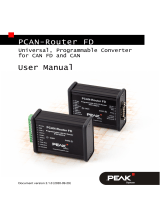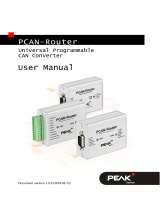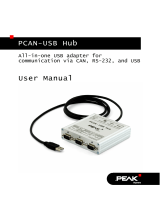
PCAN-Router Pro FD – User Manual
5
1 Introduction
With six channels, the PCAN-Router Pro FD links the data traffic of
modern CAN FD and classic CAN buses. Pluggable CAN transceiver
modules allow flexible adaptation of each CAN channel to the
respective requirements. In addition, the router is equipped with an
analog input and four digital I/Os.
The CAN messages can be recorded on the internal memory or on
an inserted memory card and later read out via the USB connection.
With the PCAN-Router Pro FD the data flow of test benches and
production plants can be managed, monitored, and controlled. The
conversion from CAN to CAN FD or vice versa enables the
integration of new CAN FD applications into existing CAN 2.0
networks.
The behavior of the PCAN-Router Pro FD can be programmed freely
for specific applications. The firmware is created using the included
development package with GNU compiler for C and C++ and is then
transferred to the module via CAN. Various programming
examples, such as message forwarding or recording, facilitate the
implementation of own solutions.
1.1 Properties at a Glance
6 High-speed CAN channels (ISO 11898-2)
Complies with CAN specifications 2.0 A/B and FD
CAN FD support for ISO and Non-ISO standards
CAN FD bit rates for the data field (64 bytes max.) from
40 kbit/s up to 12 Mbit/s
CAN bit rates from 40 kbit/s up to 1 Mbit/s
NXP CAN transceiver TJA1043 with Wake-up
























